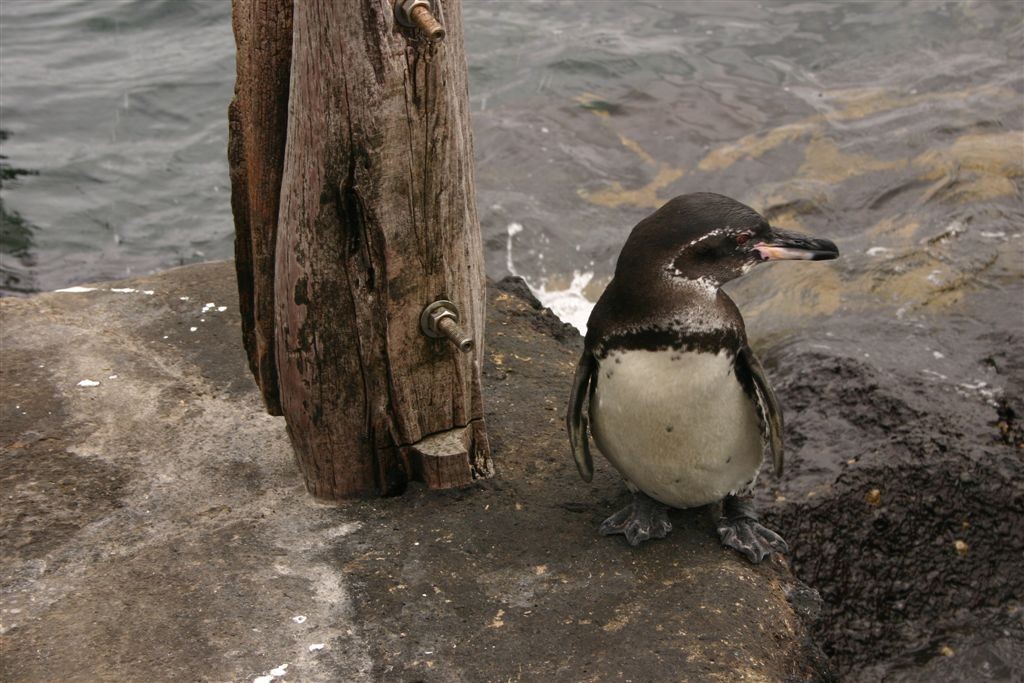Galapagos Penguin
A species of Banded penguins Scientific name : Spheniscus mendiculus Genus : Banded penguins
Galapagos Penguin, A species of Banded penguins
Botanical name: Spheniscus mendiculus
Genus: Banded penguins
Content
Description People often ask General Info
 Photo By Richard Jenkinson , used under CC-BY-SA-2.0 /Cropped and compressed from original
Photo By Richard Jenkinson , used under CC-BY-SA-2.0 /Cropped and compressed from original Description
The average Galápagos penguin is 49–50 centimetres (19–20 in) tall and weighs around 2.5–4.5 kilograms (5.5–9.9 lb). It is the second smallest species of penguin, after the little penguin. Females are usually smaller than males. Galápagos penguins have a black head with a white border running from behind the eye, around the black ear coverts and chin, to join on the throat. The top of the beaks are black and fade into pink on the bottom. They have two black bands across the breast that connect to the back, the lower band extending down the flanks to the thigh. Juveniles differ in having a wholly dark head, grayer on side and chin, and no breast band. 
Size
53 cm
Life Expectancy
15-20 years
Nest Placement
Ground
Feeding Habits
Galapagos Penguin primarily consumes small fish, hunting through diving. It exhibits diurnal foraging behavior, with a specialized diet reflecting the availability of local marine resources. Unique adaptations include counter-current heat exchangers and minimized limb surface area, allowing for extended feeding periods in cold waters.
Habitat
Galapagos Penguin reside in the tropical oceanic waters of marine environments, specialized in rocky shores along sheltered bays and inlets crafted by ancient lava. They thrive in areas with gentle interfaces between land and sea, enabling easy access to the water. Their existence depends on the cool currents within these regions that foster a rich marine ecosystem.
Dite type
Piscivorous
People often ask
General Info
Feeding Habits
Bird food type
Behavior
The penguins are confined to the archipelago, foraging in the cool Cromwell Current during the day and returning to the land at night. They eat small schooling fish, mainly mullet and sardines, and sometimes crustaceans. They normally range only a few kilometers from their breeding sites, depending on the cold, nutrient-rich currents to bring them food. Air temperatures in the Galápagos remain in the range 15–28 °C (59–82 °F). During El Niño seasons, the penguins defer breeding because their food becomes less abundant; this makes the chances of raising offspring successfully unfavorable compared to the chances of dying in the attempt. This was especially detrimental during the 1982-83 El Niño, where a decline in population of 77% was observed. The penguins usually breed when the sea surface temperature is below 25 °C (77 °F). The strong tropical sun is problematic for this species. Their primary means of cooling off is going in the water, but other behavioral adaptations for thermoregulation come into play when they must remain on land. One method involves stretching out their flippers and hunching forward to keep the sun from shining on their feet, which exchange heat rapidly because they have high blood flow and lack insulation. Another method is to pant, using evaporation to cool the throat and airways. Galápagos penguins protect their eggs and chicks from the hot sun by keeping them in deep crevices in the rocks. 
Distribution Area
Ninety percent of Galápagos penguins live on Fernandina Island and the west coast of Isabela Island, in the western part of the archipelago, but small populations also occur on Santiago, Bartolomé, northern Santa Cruz, and Floreana. The northern tip of Isabela crosses the equator, meaning that some Galápagos penguins live in the northern hemisphere, the only penguins to do so. 
Species Status
ENDANGERED. Global population estimated at fewer than 2000 individuals, of which c. 95% in W Galapagos (on Isabela I and Fernandina I).
Scientific Classification
Phylum
Chordates Class
Birds Order
Penguins Family
Penguins Genus
Banded penguins Species
Galapagos Penguin